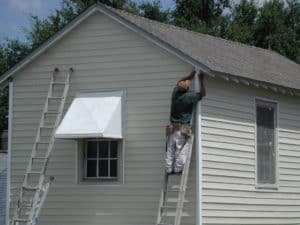Modern materials typically used for siding on residential homes have improved and are designed for longevity. However, even the best materials are subject to wear and damage and will eventually need to be replaced. Below are some common signs that your siding is beyond repair and needs to be replaced to avoid further damage to the rest of your home.
Mold and Mildew
If the siding has been damaged or was not properly sealed, stagnant water from rain or melted snow can be trapped in unexposed places. This can facilitate the growth of bacteria, mold, and mildew. If you are able to identify this problem, act quickly and replace the affected areas as soon as possible. You do not want the mold or mildew to spread into your air circulation, roof, insulation, walls, etc. This can create an even more costly and potentially dangerous situation if not resolved quickly.
Insect Damage
With some types of wooden siding, there is a chance it can become infested with earwigs, wasps, bees, and other insects. Termites can be even more damaging. If you notice small holes in your siding, it might be a sign that insects have burrowed inside it.
These same holes can lead to water damage and the mold and mildew mentioned above. Please call an exterminator and consult with your local exterior design consultant if the siding needs to be replaced.
Structural Damage
With the passing of time, some foundations under houses may settle causing the structure of the house to shift. The result to your siding may be bending, cracking, breaking, or just moving out of alignment. In addition to the obvious aesthetic problem, your house is now more vulnerable to the effects of moisture and insects already mentioned. If the siding must be replaced, the delay is not in your best interest.
Making the best choice for siding material and installation
There are a number of different types of siding materials you may choose for your home. Which one is best for you, will depend on a number of factors which can include aesthetics and cost. Based on the inherent vulnerabilities where you live, you must also consider the qualities in materials that may make them resistant to water, mold and mildew, insects and fire.
While vinyl siding can last for decades, it may also only last a year if not properly installed. It is important to you work with a professional home siding installation company to perform these services. Your siding can also become damaged if it was nailed too tightly or on an angle. The resulting tension can cause it to bend, snap, or crack. If you are unable to slide the siding horizontally by approximately ½ inch, then it was nailed too tightly.
An engineered wood such as LP SmartWood is resistant to impact, insects, mold, and mildew but can swell from moisture if non-factory cuts are not sealed properly during installation. It is also not recommended in areas that are more vulnerable to fire. LP SmartWood comes in very attractive wood textures and colors. Cost may vary depending on whether it is painted after installation or ordered prepainted.
Fiber cement siding can also look and feel like wood. It is resistant to insects, mold, mildew, and fire. It is not very resistant to damage from impact and the color is not embedded in the material so it may need to be repainted every 12-15 years. It is also 2-3 times more expensive than vinyl.
Rock Top Construction, LLC is a local contractor that specializes in home exteriors. Our Design Consultants can help you select the siding that best fits your needs. We also maintain a pool of the most qualified and reliable installation contractors who specialize in the various material options available for your home. Our services include roofing, siding, windows, doors, HVAC and more! Contact a consultant today to get your free inspection.

